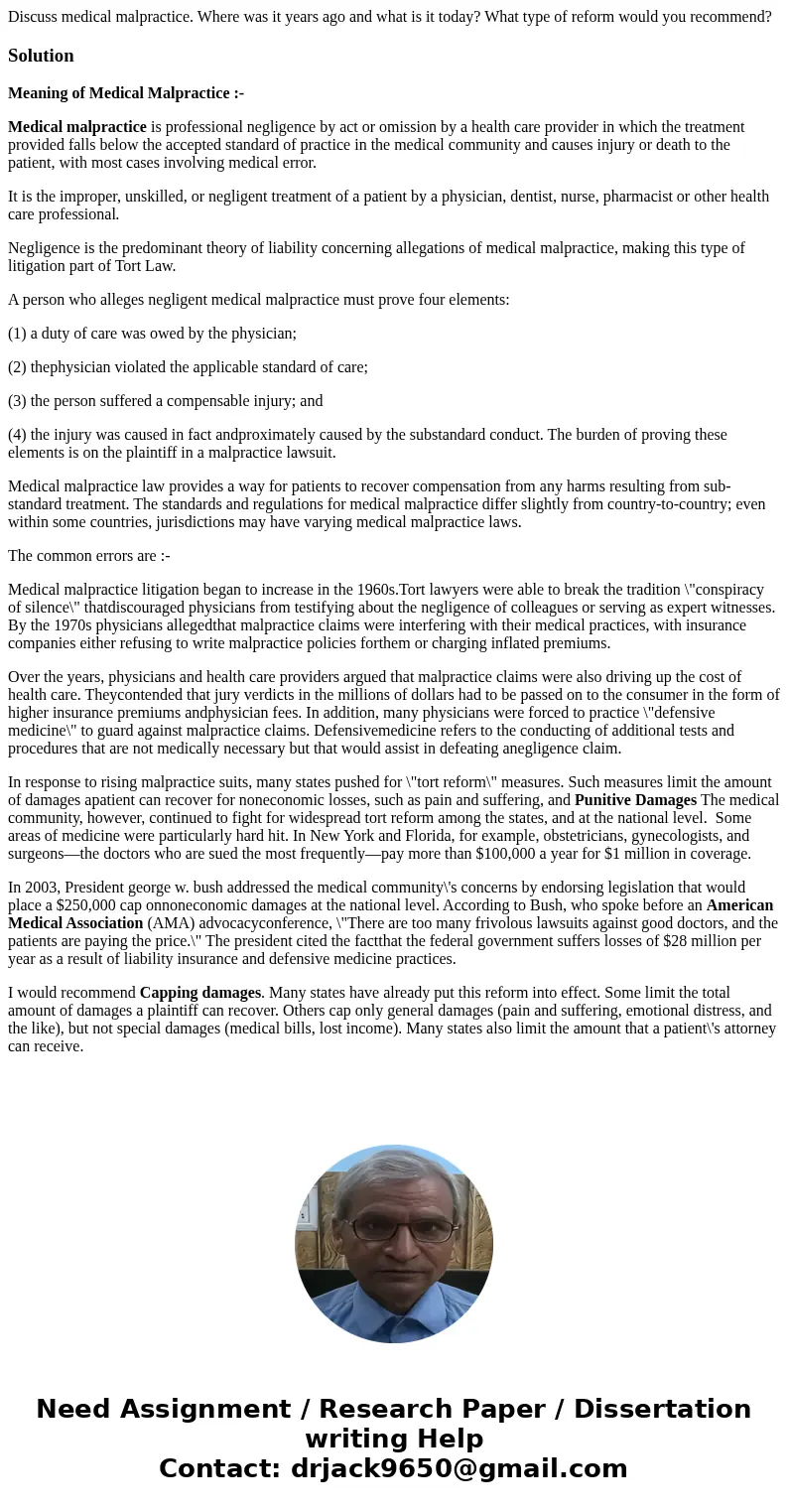Discuss medical malpractice Where was it years ago and what
Discuss medical malpractice. Where was it years ago and what is it today? What type of reform would you recommend?
Solution
Meaning of Medical Malpractice :-
Medical malpractice is professional negligence by act or omission by a health care provider in which the treatment provided falls below the accepted standard of practice in the medical community and causes injury or death to the patient, with most cases involving medical error.
It is the improper, unskilled, or negligent treatment of a patient by a physician, dentist, nurse, pharmacist or other health care professional.
Negligence is the predominant theory of liability concerning allegations of medical malpractice, making this type of litigation part of Tort Law.
A person who alleges negligent medical malpractice must prove four elements:
(1) a duty of care was owed by the physician;
(2) thephysician violated the applicable standard of care;
(3) the person suffered a compensable injury; and
(4) the injury was caused in fact andproximately caused by the substandard conduct. The burden of proving these elements is on the plaintiff in a malpractice lawsuit.
Medical malpractice law provides a way for patients to recover compensation from any harms resulting from sub-standard treatment. The standards and regulations for medical malpractice differ slightly from country-to-country; even within some countries, jurisdictions may have varying medical malpractice laws.
The common errors are :-
Medical malpractice litigation began to increase in the 1960s.Tort lawyers were able to break the tradition \"conspiracy of silence\" thatdiscouraged physicians from testifying about the negligence of colleagues or serving as expert witnesses. By the 1970s physicians allegedthat malpractice claims were interfering with their medical practices, with insurance companies either refusing to write malpractice policies forthem or charging inflated premiums.
Over the years, physicians and health care providers argued that malpractice claims were also driving up the cost of health care. Theycontended that jury verdicts in the millions of dollars had to be passed on to the consumer in the form of higher insurance premiums andphysician fees. In addition, many physicians were forced to practice \"defensive medicine\" to guard against malpractice claims. Defensivemedicine refers to the conducting of additional tests and procedures that are not medically necessary but that would assist in defeating anegligence claim.
In response to rising malpractice suits, many states pushed for \"tort reform\" measures. Such measures limit the amount of damages apatient can recover for noneconomic losses, such as pain and suffering, and Punitive Damages The medical community, however, continued to fight for widespread tort reform among the states, and at the national level. Some areas of medicine were particularly hard hit. In New York and Florida, for example, obstetricians, gynecologists, and surgeons—the doctors who are sued the most frequently—pay more than $100,000 a year for $1 million in coverage.
In 2003, President george w. bush addressed the medical community\'s concerns by endorsing legislation that would place a $250,000 cap onnoneconomic damages at the national level. According to Bush, who spoke before an American Medical Association (AMA) advocacyconference, \"There are too many frivolous lawsuits against good doctors, and the patients are paying the price.\" The president cited the factthat the federal government suffers losses of $28 million per year as a result of liability insurance and defensive medicine practices.
I would recommend Capping damages. Many states have already put this reform into effect. Some limit the total amount of damages a plaintiff can recover. Others cap only general damages (pain and suffering, emotional distress, and the like), but not special damages (medical bills, lost income). Many states also limit the amount that a patient\'s attorney can receive.

 Homework Sourse
Homework Sourse